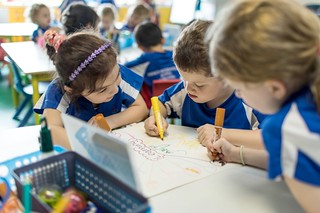Please click on the photo or here to view the flickr album.
Year 1
Students in Year 1A worked in small groups to share what they knew already about the brain and learning. What does learning look like? How do we learn? How can we look after our brain? The children recorded their ideas in a visual form: a mind map that helped to reinforce the notion that the brain learns by making connections.
They also been enjoying answering regular brain-teasers, placing their answers in our state-of-the-art ‘Brain Box’. Do the children display two of our IPC Personal Goals, adaptability and resilience?
Students enjoyed working in groups to complete jigsaws. Without the picture on the box to guide them, some of the puzzles were challenging. When we know the ‘bigger picture’, however, we have a better idea of how the pieces may fit together. Our learning is like a big jigsaw. All our subjects and activities combine to make one whole.
Year 2
Students were able to examine and touch (jelly) brains, and now are working through a challenge set for them by renowned neuroscientist Professor Spark.
Year 4
As part of the Brainwave unit the children have been learning about different learning styles. They then had to think of all the different ways that they might teach someone a skill. For instance: Writing a set of instructions, giving a short talk, preparing a brief demonstration, creating a tutorial video etc. The children got together with another group and tried their methods out. We had skills such as loom band bracelet making, how to apply make-up, hair styles, basketball, guitar and drawing to name just a few. The children did an excellent job and thoroughly enjoyed the process.
Year 5
Students showed Cooperation and Resilience to create circuits for their home made Brain models. In groups of two or three, they presented their different projects about the brain to their parents on Friday 6 October. Using computers, paper or white boards to show off their technical knowledge, share their experiences and the prototypes they built, students demonstrated how much they really enjoyed working on the brain.

